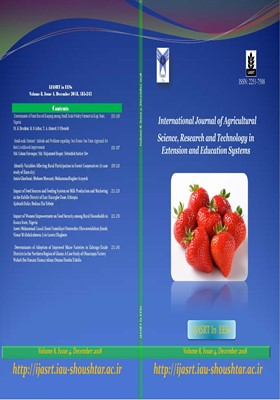Impact of Feed Sources and Feeding System on Milk Production and Marketing in the Babille District of East Hararghe Zone, Ethiopia
محورهای موضوعی : Agricultural ExtensionAjabush Dafar 1 , Bedasa Tebeje 2
1 - Holeta, Ethiopia
2 - Agricultural sciences
کلید واژه: milk production, Feed sources, Feeding system, Milk Marketing,
چکیده مقاله :
The aim of this article was to investigate the impact of feed sources and feeding system on milk production and milk marketing in the Babille district of Eastern Hararghe zone. Data were collected using a structured questionnaire which was administered to 152 randomly selected sample dairy cow keepers in the district. Data was analyzed using descriptive methods and regression analysis. Data from regression analysis demonstrated that the different factors had a different effect on the milk produced. The factors with strongest influence on the milk yield were dry fodder, green fodder, labor and number of cows. Feed is set to remain the most important and manageable component of commercial livestock production. Results clearly show that, in addition to dry fodder, the green fodder obtained through thinning of sorghum and maize highly affects milk production positively. Hence, ways of integrating cereal production with dairy production and efficient utilization of existing feed sources should be sought. So if energy dense sources of feed is adopted for the dairy producers in the study area, they may diversify their feed sources and could lessen risk related livestock feed and livelihood. The high cost of feeds and unimproved feeding system is a universal constraint in livestock production of the study area.
10. DoARD (District of Agriculture and rural Development), (2014). Annual report, East Hararge, Ethiopia.
11. DoARD (District of Agriculture and rural Development), (2015). Annual report, East Hararge, Ethiopia
12. FAO (Food and Agriculture Organization of the United Nations), (2014). Crop Diversification and Marketing Development Project, Interim Report. Addis Ababa, Ethiopia.
13. Gatev,K., Koseva, D., Spasov,.,1991. General Theory of Statistics. 274.
14. GRM (Government Resources Management) International BV (Best Value). (2007). Livestock Development Master Plan Study. Phase I Report – Data Collection and Analysis. Volume 1 – Dairy.
15. Haile, W., Zelalem, Y., Yosef, T. (2012). Challenges and opportunities of milk production under different urban dairy farm sizes in Hawassa City, Southern Ethiopia. Af J Agric Res. 2012;7(26):3860–3866.
16. IGAD-LPI (Inter-Governmental Authority on Development-Livestock Policy Initiative), (2011). The contribution of livestock to the Ethiopian economy—part I
17. Lalrinsangpuii, M and Ravinder, M. (2016). Resource Use Efficiency in Milk Production in Mizoram State of North-East India. Division of Dairy Economics, Statistics & Management, National Dairy Research Institute, Karnal, Haryana, INDIA .DOI: 10.5958/2277 940X.2016.00041
18. Land O’Lakes, Inc. (2010). Ethiopia Dairy Value chains, USAID CA No 6633-A-00-05-00431-00 Land O’Lakes Inc. IDD. Addis Abeba, Ethiopia.
19. Nathaniel, M., Tsehay, R., Jan van der, L., Raphael, M. and Akke van der Zijpp. (2014). White Gold: Opportunities for Dairy Sector Development Collaboration in East Africa Centre for Development Innovation. Wageningen.
20. Teshager, A., Belay, D and Taye, T. (2013). Traditional cattle fattening and live animal marketing system in different agro ecologies of Ilu Ababora zone, Oromia, Ethiopia Global Veterinarian 10 (5): 620-625
21. Zewdie, A., Shiferaw, K and Berhanu, G. (2015). Sources of technical inefficiency of smallholder farmers in milk production in Ethiopia. LIVES Working Paper 3. Nairobi, Kenya: International Livestock Research Institute (ILRI).


